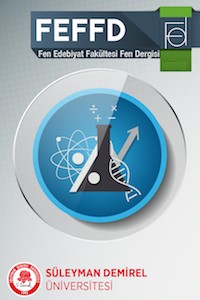Abstract
Yinelemeli fonksiyon sistemleri (YFS) fraktal geometrinin önemli araçlarından biridir. Çizge-yönlendirilmiş yinelemeli fonksiyon sistemleri (ÇYFS) ise klasik yinelemeli fonksiyon sistemlerininin bir genelleştirmesi olarak literatürde yer almaktadır. Diğer taraftan, sonlu sayıda büzülme dönüşümü ve bir sıklaştırma dönüşümünden (sabit dönüşüm) oluşan sıklaştırma fonksiyonlu yinelemeli fonksiyon sistemleri de bir başka önemli genelleştirme olarak karşımıza çıkmaktadır. Bu çalışmada ise, sıklaştırma fonksiyonlu çizge-yönlendirilmiş yinelemeli fonksiyon sistemleri, klasik sıklaştırma fonksiyonlu yinelemeli fonksiyon sistemlerinin bir genellemesi olarak tanımlanmış ve bu yeni kavram örneklendirilmiştir. Ayrıca tanımlanan sıklaştırma fonksiyonlu çizge-yönlendirilmiş sistemin atraktörlerinin Hausdorff boyutları üzerinde durulmuştır. Bir sıklaştırma fonksiyonlu YFS’nin atraktörünün Hausdorff boyutu için klasik durumda var olan bir takım sonuçların, bu yeni tanımlanan sistemlerin atraktörleri için de geçerli olduğu gösterilmiştir.
Keywords
Hausdorff boyut Sıklaştırma Fonksiyonu Yinelemeli Fonksiyon Sistemi (YFS) Çizge-yönlendirilmiş YFS
Thanks
Bu çalışma Anadolu Üniversitesi tarafından 1605F473 numaralı araştırma projesi kapsamında desteklenmiştir.
References
- [1] M. F. Barnsley, Fractals Everywhere. New York: Academic Press, 1988.
- [2] M. F. Barnsley and S. Demko, “Iterated function systems and the global construction of fractals,” Proc. R. Soc. Lond. Ser. A, 399, 243-275, 1985.
- [3] J. E. Hutchinson, “Fractals and self-similarity,” Indiana Univ. Math. J., 30, 713–747, 1981.
- [4] G. Edgar, Measure, Topology and Fractal Geometry. New York: Springer, 2008.
- [5] R. D. Mauldin and S.C. Williams, “Hausdorff dimension in graph directed constructions,” Trans. Amer. Math. Soc., 309(2), 811–829, 1988.
- [6] S. Baker, J. M. Fraser, and A. Máthé, “Inhomogeneous self-similar sets with overlaps,” Ergod. Theor. Dyn. Syst., 39(1), 1–18, 2019.
- [7] Z. G. Yu, V. V. Anh, and K. S. Lau, “Hausdorff dimension of random fractals with overlaps,” Bull. Aust. Math. Soc., 65(2), 315–328, 2002.
- [8] Y. Li, “Fractal dimension estimation for color texture images,” J. Math. Imaging Vision, 62, 37-53, 2020.
- [9] N. Snigireva, “Inhomogeneous Self-similar Sets and Measures,” Ph.D Dissertation, University of St Andrews, 2008.
- [10] J. M. Fraser, “Inhomogeneous self-similar sets and box dimensions,” Studia Mathematica, 213(2), 133– 155, 2012.
- [11] M. Holland and Y. Zhang, “Dimension results for inhomogeneous Moran set constructions,” Dynamical Systems, 28(2), 222-250, 2013.
- [12] G. Edgar and J. Golds, “A fractal dimension estimate for a graph-directed iterated function system of non-similarities,” Indiana Univ. Math. J., 48(2), 429–447, 1999.
- [13] P. R. Massopust, Fractal functions, fractal surfaces, and wavelets. 2nd edition, Amsterdam: Academic Press, 2016.
Abstract
The notion of (classical) iterated function system (IFS) is one of the important tools in fractal geometry. Graph-directed iterated function system (GIFS) is a well-known generalization of the classical IFS. However, “iterated function system with condensation (or inhomogeneous IFS)” which consists of finite number of contractions and a condensation map can also be considered as another generalization of IFS. In this study, mainly, we define the notion of “graph-directed iterated function system with condensation (GIFS with condensation)” as a generalization of the classical “iterated function system with condensation”, and give an example. Moreover, we investigate the Hausdorff dimensions of the attractors of this new system. And by using the existing results of the classical case, we obtain similar results for the attractors of a GIFS with condensation.
References
- [1] M. F. Barnsley, Fractals Everywhere. New York: Academic Press, 1988.
- [2] M. F. Barnsley and S. Demko, “Iterated function systems and the global construction of fractals,” Proc. R. Soc. Lond. Ser. A, 399, 243-275, 1985.
- [3] J. E. Hutchinson, “Fractals and self-similarity,” Indiana Univ. Math. J., 30, 713–747, 1981.
- [4] G. Edgar, Measure, Topology and Fractal Geometry. New York: Springer, 2008.
- [5] R. D. Mauldin and S.C. Williams, “Hausdorff dimension in graph directed constructions,” Trans. Amer. Math. Soc., 309(2), 811–829, 1988.
- [6] S. Baker, J. M. Fraser, and A. Máthé, “Inhomogeneous self-similar sets with overlaps,” Ergod. Theor. Dyn. Syst., 39(1), 1–18, 2019.
- [7] Z. G. Yu, V. V. Anh, and K. S. Lau, “Hausdorff dimension of random fractals with overlaps,” Bull. Aust. Math. Soc., 65(2), 315–328, 2002.
- [8] Y. Li, “Fractal dimension estimation for color texture images,” J. Math. Imaging Vision, 62, 37-53, 2020.
- [9] N. Snigireva, “Inhomogeneous Self-similar Sets and Measures,” Ph.D Dissertation, University of St Andrews, 2008.
- [10] J. M. Fraser, “Inhomogeneous self-similar sets and box dimensions,” Studia Mathematica, 213(2), 133– 155, 2012.
- [11] M. Holland and Y. Zhang, “Dimension results for inhomogeneous Moran set constructions,” Dynamical Systems, 28(2), 222-250, 2013.
- [12] G. Edgar and J. Golds, “A fractal dimension estimate for a graph-directed iterated function system of non-similarities,” Indiana Univ. Math. J., 48(2), 429–447, 1999.
- [13] P. R. Massopust, Fractal functions, fractal surfaces, and wavelets. 2nd edition, Amsterdam: Academic Press, 2016.
Details
| Primary Language | Turkish |
|---|---|
| Subjects | Mathematical Sciences |
| Journal Section | Makaleler |
| Authors | |
| Publication Date | May 31, 2020 |
| Published in Issue | Year 2020 Volume: 15 Issue: 1 |


